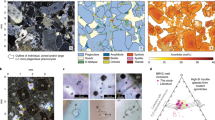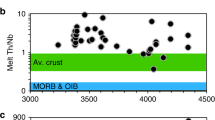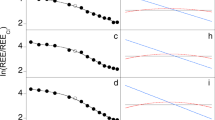Abstract
The oldest known samples of Earth, with ages of up to 4.4 Gyr, are detrital zircon grains in meta-sedimentary rocks of the Jack Hills in Australia. These zircons offer insights into the magmas from which they crystallized, and, by implication, igneous activity and tectonics in the first 500 million years of Earth’s history, the Hadean eon. However, the compositions of these magmas and the relative contributions of igneous and sedimentary components to their sources have not yet been resolved. Here we compare the trace element concentrations of the Jack Hills zircons to those of zircons from the locality where igneous (I-) and sedimentary (S-) type granites were first distinguished. We show that the Hadean zircons crystallized predominantly from I-type magmas formed by melting of a reduced, garnet-bearing igneous crust. Further, we propose that both the phosphorus content of zircon and the ratio of phosphorus to rare earth elements can be used to distinguish between detrital zircon grains from I- and S-type sources. These elemental discriminants provide a new geochemical tool to assess the relative contributions of primeval magmatism and melting of recycled sediments to the continents over geological time.
This is a preview of subscription content, access via your institution
Access options
Access Nature and 54 other Nature Portfolio journals
Get Nature+, our best-value online-access subscription
$29.99 / 30 days
cancel any time
Subscribe to this journal
Receive 12 print issues and online access
$259.00 per year
only $21.58 per issue
Buy this article
- Purchase on Springer Link
- Instant access to full article PDF
Prices may be subject to local taxes which are calculated during checkout



Similar content being viewed by others
References
Compston, W. & Pidgeon, R. T. Jack Hills, evidence of more very old detrital zircons in Western Australia. Nature 321, 766–769 (1986).
Coogan, L. A. & Hinton, R. W. Do the trace element compositions of detrital zircons require Hadean continental crust? Geology 34, 633–636 (2006).
Carley, T. L. et al. Iceland is not a magmatic analog for the Hadean: evidence from the zircon record. Earth Planet. Sci. Lett. 405, 85–97 (2014).
Grimes, C. B. et al. Trace element chemistry of zircons from oceanic crust: a method for distinguishing detrital zircon provenance. Geology 35, 643–646 (2007).
Harrison, T. M., Watson, E. B. & Aikman, A. B. Temperature spectra of zircon crystallization in plutonic rocks. Geology 35, 635–638 (2007).
Bell, E. A., Boehnke, P. & Harrison, T. M. Recovering the primary geochemistry of Jack Hills zircons through quantitative estimates of chemical alteration. Geochim. Cosmochim. Acta 191, 187–202 (2016).
Cavosie, A. J., Valley, J. W., Wilde, S. A. & E. I. M. F. Correlated microanalysis of zircon: trace element, δ18O, and U–Th–Pb isotopic constraints on the igneous origin of complex >3,900 Ma detrital grains. Geochim. Cosmochim. Acta 70, 5601–5616 (2006).
Kemp, A. I. S. et al. Hadean crustal evolution revisited: new constraints from Pb–Hf isotope systematics of the Jack Hills zircons. Earth Planet. Sci. Lett. 296, 45–56 (2010).
Harrison, T. M., Schmitt, A. K., McCulloch, M. T. & Lovera, O. M. Early (≥ 4.5 Ga) formation of terrestrial crust: Lu–Hf, δ18O, and Ti thermometry results for Hadean zircons. Earth Planet. Sci. Lett. 268, 476–486 (2008).
Vervoort, J. D. & Kemp, A. I. S. Clarifying the zircon Hf isotope record of crust-mantle evolution. Chem. Geol. 425, 65–75 (2016).
Hopkins, M. D., Harrison, T. M. & Manning, C. E. Low heat flow inferred from >4 Gyr zircons suggests Hadean plate boundary interactions. Nature 456, 493–496 (2008).
Hopkins, M. D., Harrison, T. M. & Manning, C. E. Constraints on Hadean geodynamics from mineral inclusions in >4 Ga zircons. Earth Planet. Sci. Lett. 298, 367–376 (2010).
Marchi, S. et al. Widespread mixing and burial of Earth’s Hadean crust by asteroid impacts. Nature 511, 578–582 (2014).
Kenny, G. G., Whitehouse, M. J. & Kamber, B. S. Differentiated impact melt sheets may be a potential source of Hadean detrital zircon. Geology 44, 435–438 (2016).
Chappell, B. W. & White, A. J. R. I- and S-type granites in the Lachlan Fold Belt. Trans. R. Soc. Edinb. 83, 1–26 (1992).
Ickert, R. B. & Williams, I. S. U–Pb zircon geochronology of Silurian–Devonian granites in southeastern Australia: implications for the timing of the Benambran Orogeny and the I–S dichotomy. Aust. J. Earth Sci. 58, 501–516 (2011).
Roberts, M. P. & Clemens, J. D. Origin of high-potassium, calc-alkaline, I-type granitoids. Geology 21, 825–828 (1993).
Clemens, J. D. & Stevens, G. What controls chemical variation in granitic magmas? Lithos 134–135, 317–329 (2012).
Kemp, A. I. S. et al. Magmatic and crustal differentiation history of granitic rocks from Hf-O isotopes in zircon. Science 315, 980–983 (2007).
Chappell, B. W. Tectonic evolution of the eastern Australian fold belts from a granite-based perspective: 1998 Mawson lecture. Aust. Geol. 109, 24–30 (1988).
London, D. Phosphorus in S-type magmas: the P2O5 content of feldspars from peraluminous granites, pegmatites, and rhyolites. Am. Mineral. 77, 126–145 (1992).
Pichavant, M., Montel, J.-M. & Richard, L. R. Apatite solubility in peraluminous liquids: experimental data and an extension of the Harrison–Watson model. Geochim. Cosmochim. Acta 56, 3855–3861 (1992).
Sawka, W. N., Banfield, J. F. & Chappell, B. W. A weathering-related origin of widespread monazite in S-type granites. Geochim. Cosmochim. Acta 50, 171–175 (1986).
Burnham, A. D. & Berry, A. J. An experimental study of trace element partitioning between zircon and melt as a function of oxygen fugacity. Geochim. Cosmochim. Acta 95, 196–212 (2012).
Trail, D., Watson, E. B. & Tailby, N. D. The oxidation state of Hadean magmas and implications for early Earth’s atmosphere. Nature 480, 79–82 (2011).
Bell, E. A., Boehnke, P., Hopkins-Wielicki, M. D. & Harrison, T. M. Distinguishing primary and secondary inclusion assemblages in Jack Hills zircons. Lithos 234–235, 15–26 (2015).
Rasmussen, B., Fletcher, I. R., Muhling, J. R., Gregory, C. J. & Wilde, S. A. Metamorphic replacement of mineral inclusions in detrital zircon from Jack Hills, Australia: implications for the Hadean Earth. Geology 39, 1143–1146 (2011).
Barbarin, B. Genesis of the two main types of peraluminous granitoids. Geology 24, 295–298 (1996).
Darling, J., Storey, C. & Hawkesworth, C. Impact melt sheet zircons and their implications for the Hadean crust. Geology 37, 927–930 (2009).
Cameron, E. D., Valley, J. W., Ortiz-Cordero, D., Kitajima, K. & Cavosie, A. J. Detrital Jack Hills zircon-quartz δ18O analysis rests alteration of zircon and zircon inclusions. Goldschmidt Conference Abstracts abstr. 349 (2016).
Valley, J. W. in Zircon: Reviews in Mineralogy and Geochemistry Vol. 53 (eds Hanchar, J. M. & Hoskin, P. W. O.) 343–385 (Mineralogical Society of America/Geochemical Society, 2003).
Sánchez-Garrido, C. J. M. G. et al. Diversity in Earth’s early felsic crust: paleoarchean peraluminous granites of the Barberton Greenstone Belt. Geology 39, 963–966 (2011).
Stepanov, A. S., Hermann, J., Rubato, D. & Rapp, R. P. Experimental study of monazite/melt partitioning with implications for the REE, Th and U geochemistry of crustal rocks. Chem. Geol. 300–301, 200–220 (2012).
Prowatke, S. & Klemme, S. Effect of melt composition on the partitioning of trace elements between titanite and silicate melt. Geochim. Cosmochim. Acta 69, 695–709 (2005).
Therriault, A. M., Fowler, A. D. & Grieve, R. A. F. The Sudbury Igneous Complex: a differentiated impact melt sheet. Econ. Geol. 97, 1521–1540 (2002).
Wielicki, M. M., Harrison, T. M., Schmitt, A. K., Boehnke, P. & Bell, E. A. Differentiated impact melt sheets may be a potential source of Hadean detrital zircon: COMMENT. Geology 44, e398 (2016).
Chappell, B. W., White, A. J. R. & Wyborn, D. The importance of residual source material (restite) in granite petrogenesis. J. Petrol. 28, 1111–1118 (1987).
Stevens, G., Villaros, A. & Moyen, J.-F. Selective peritectic garnet entrainment as the origin of geochemical diversity in S-type granites. Geology 35, 9–12 (2007).
Linnen, R. L. & Keppler, H. Melt composition control of Zr/Hf fractionation in magmatic processes. Geochim. Cosmochim. Acta 66, 3293–3301 (2002).
Smythe, D. J. & Brenan, J. M. Magmatic oxygen fugacity estimated using zircon-melt partitioning of cerium. Earth Planet. Sci. Lett. 453, 260–266 (2016).
Trail, D., Tailby, N. D., Sochko, M. & Ackerson, M. R. Possible biosphere-lithosphere interactions preserved in igneous zircon and implications for Hadean Earth. Astrobiology 15, 575–586 (2015).
Foden, J., Sossi, P. A. & Wawryk, C. M. Fe isotopes and the contrasting petrogenesis of A-, I- and S-type granite. Lithos 212–215, 32–44 (2015).
Wang, Q. et al. Magmatic zircons from I-, S- and A-type granitoids in Tibet: trace element characteristics and their application to detrital zircon provenance study. J. Asian Earth Sci. 53, 59–66 (2012).
Yang, X., Gaillard, F. & Scaillet, B. A relatively reduced Hadean continental crust and implications for the early atmosphere and crustal rheology. Earth Planet. Sci. Lett. 393, 210–219 (2014).
Rapp, R. P. & Watson, E. B. Dehydration melting of metabasalt at 8–32 kbar: implications for continental growth and crust-mantle recycling. J. Petrol. 36, 891–931 (1995).
Moyen, J.-F. & Stevens, G. in Archean Geodynamics and Environments Geophysical Monograph Series 164 (eds Benn, K., Mareschal, J.-C. & Condie, K. C.) 149–175 (2006).
Reimink, J. R., Chacko, T., Stern, R. A. & Heaman, L. M. Earth’s earliest evolved crust generated in an Iceland-like setting. Nat. Geosci. 7, 529–533 (2013).
Hoskin, P. W. & Ireland, T. R. Rare earth element chemistry of zircon and its use as a provenance indicator. Geology 28, 627–630 (2000).
Whitehouse, M. J. & Kamber, B. S. On the overabundance of light rare earth elements in terrestrial zircons and its implication for Earth’s earliest magmatic differentiation. Earth Planet. Sci. Lett. 204, 333–346 (2002).
Bouvier, A. S. et al. Li isotopes and trace elements as a petrogenetic tracer in zircon: insights from Archean TTGs and sanukitoids. Contrib. Mineral. Petrol. 163, 745–768 (2012).
Chappell, B. W. Advances in X-ray Analysis 263–276 (Springer, 1991).
Wiedenbeck, M. et al. Further characterisation of the 91500 zircon crystal. Geostand. Geoanal. Res. 28, 9–39 (2004).
Hinton, R. W. & Upton, B. G. J. The chemistry of zircon: variations within and between large crystals from syenite and alkali basalt xenoliths. Geochim. Cosmochim. Acta 55, 3287–3302 (1991).
Onuma, N., Higuchi, H., Wakita, H. & Nagasawa, H. Trace element partition between two pyroxenes and the host lava. Earth Planet. Sci. Lett. 5, 47–51 (1968).
Black, L. P. et al. Improved 206Pb/238U microprobe geochronology by the monitoring of a trace-element-related matrix effect; SHRIMP, ID–TIMS, ELA–ICP–MS and oxygen isotope documentation for a series of zircon standards. Chem. Geol. 205, 115–140 (2004).
Rubatto, D. & Hermann, J. Experimental zircon/melt and zircon/garnet trace element partitioning and implications for the geochronology of crustal rocks. Chem. Geol. 241, 38–61 (2007).
Sano, Y., Terada, K. & Fukuoka, T. High mass resolution ion microprobe analysis of rare earth elements in silicate glass, apatite and zircon: lack of matrix dependency. Chem. Geol. 184, 217–230 (2002).
Acknowledgements
We thank R. Ickert and I. Williams for providing the zircons, N. Badullovich for preparing some of the samples, and C. Allen for assistance with LA-ICP-MS. A.J.B. thanks the Australian Research Council for the award of a Future Fellowship.
Author information
Authors and Affiliations
Contributions
A.J.B. conceived the research project, A.D.B. performed the analyses and processed the data, and both authors contributed to the data interpretation and preparation of the manuscript.
Corresponding author
Ethics declarations
Competing interests
The authors declare no competing financial interests.
Supplementary information
Supplementary Information
Supplementary Information (PDF 225 kb)
Supplementary Information
Supplementary Information (XLSX 105 kb)
Rights and permissions
About this article
Cite this article
Burnham, A., Berry, A. Formation of Hadean granites by melting of igneous crust. Nature Geosci 10, 457–461 (2017). https://doi.org/10.1038/ngeo2942
Received:
Accepted:
Published:
Issue Date:
DOI: https://doi.org/10.1038/ngeo2942
This article is cited by
-
Revisiting the Geochemical Classification of Zircon Source Rocks Using a Machine Learning Approach
Mathematical Geosciences (2024)
-
Using zircon and apatite chemistry to fingerprint porphyry Cu – Mo ± Au mineralization in the Delamerian Orogen, South Australia
Mineralium Deposita (2024)
-
I-type and S-type granites in the Earth’s earliest continental crust
Communications Earth & Environment (2023)
-
A machine learning method for distinguishing detrital zircon provenance
Contributions to Mineralogy and Petrology (2023)
-
Application of Onuma and lattice strain derived methods to calculate missing REE and Ce and Eu anomalies in magmatic zircons
Contributions to Mineralogy and Petrology (2023)



